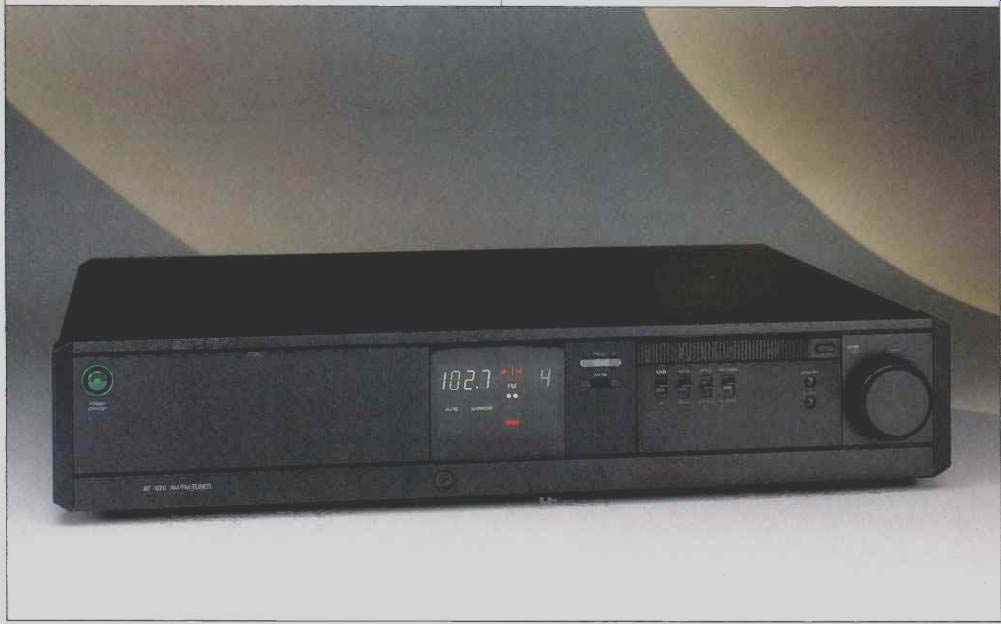
Manufacturer's Specifications
FM Tuner Section:
Mono Usable Sensitivity: 10.3 dBf.
50-dB Quieting Sensitivity: Mono, 15.3 dBf; stereo, 34.7 dBf.
THD at 65 dBf: Mono, 0.2%; stereo, 0.3%.
S/N at 65 dBf, A-Weighted: Mono, 83 dB; stereo, 74 dB.
Capture Ratio: 1.0 dB.
Alternate-Channel Selectivity: Normal, 65 dB; narrow, 80 dB.
Image Rejection: 90 dB.
I.f. Rejection: 110 dB.
AM Rejection: 65 dB.
Separation: 45 dB at 1 kHz.
AM Tuner Section:
Usable Sensitivity: 25 Selectivity: 50 dB.
Image Rejection: 45 dB.
I.f. Rejection: 50 dB.
THD: 0.5% for 30% modulation by 400-Hz signal.
S/N: 45 dB at 10 mV.
General Specifications
Dimensions: 18 1/2 in. W x 3 3/8 in. H x 15 5/8 in. D (47 cm x 9.8 cm x 39.7 cm).
Weight: 15 1/2 lbs. (7 kg).
Power Requirements: 120 V, 60 Hz a.c., 16 watts.
Price: $400.
Company Address: 5630 Cerritos Ave., Cypress, Cal. 90630, USA.
It's always a pleasure to unpack a new audio component and discover that its styling is so carefully executed that it will grace any room decor. When that elegant styling is accompanied by superb performance, as the old song goes, who could ask for anything more? Such were my reactions when I placed the new Proton AT-670 FM/AM tuner on the lab bench. I shouldn't have been surprised.
After all, styling of this, and other Proton 600 series components, was under the direction of Reinhold Weiss, an industrial designer who has gained international fame for his design work on many high-tech products. Weiss has the knack of creating audio and video components that are pleasing to look at but whose looks don't get in the way of proper operation. As for the AT-670's circuit design, I need reveal only that Proton's special consultant for some years now has been Larry Schotz, who has no rival when it comes to r.f. design.
This combination of visual and electronic design talents, aided and abetted by Proton's production facilities, has produced a tuner that any FM radio lover and connoisseur of elegantly styled audio components would be proud to own. The only negative comment I have concerning this tuner's performance has to do with its AM section. Frankly, I can't believe that Schotz had anything to do with the design of the AM circuitry; it must have been left over from a much earlier model! In any event, most of us don't buy tuners of this category to listen to AM. For that purpose, a table radio usually does just fine.
The AT-670 lets you program 18 FM station frequencies and nine AM frequencies, for a total of 27 presets. The FM tuner section is equipped with the refined Schotz Noise Reduction (SNR) system, which can be turned on and off as required. Generally, it can be left on since, for strong signals, it does not impair reception quality in any way. The tuner also has a " Normal" (wide) i.f. mode and a "Narrow" mode. The latter is to be used only in areas where stations crowd the dial and interfere with one another, since it does degrade audio performance a bit.
Control Layout At first glance, the black front panel looks as if it doesn't have enough controls to operate the AT-670. All you see are a tiny on/off button at the left, a "Preset" up/down switch, an AM/FM band switch near the center of the panel, and a large rotary tuning knob at the extreme right. Only close examination reveals a tiny button labeled "Open/Close." A push of this button, once power has been turned on, causes an entire section of the panel to move smoothly forward, disclosing additional required controls. (It reminded me of the many secret revolving doors we've all seen in detective and mystery movies.) The controls that come into view are a switch that turns on the "SNR" circuitry, another for selecting automatic or manual tuning, a third that selects "Mono" or "Stereo" operation, and a fourth that selects the "Normal" (wide) or "Narrow" i.f. mode of FM reception. Two tiny pushbuttons labeled "Memory" and "Enter," also found here, are used to set station presets. A softly lit display at the center of the front panel indicates stereo reception, tuning accuracy, and i.f. and tuning modes.
"Mains Control" jacks on the rear panel allow control links to other Proton 600 series components. This feature enables you to designate one unit of a Proton 600 series system as the master power controller and to turn all components on or off by pressing the power button on the designated master unit. In addition, major functions of this tuner, any other 600 series component, and even some Proton TV monitor/receivers can be controlled by Proton's AH-681 system re mote. In addition to the usual output jacks at the rear of the tuner, there is an output level control and provision for mounting the pivoting AM antenna loopstick provided with the AT-670. The antenna input is a standard 75-ohm coaxial connector, but an impedance-matching transformer is sup plied for those who use 300-ohm twin-lead cable from their antennas. Additional slide switches on the rear panel select 75-µS FM de-emphasis for use in the U.S. or 50-uS de-emphasis for use in some foreign countries, and 10-kHz ( U.S.) or 9-kHz (European) spacing between AM channels.
Measurements
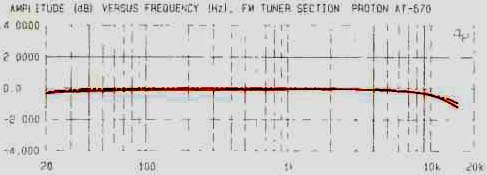
Fig. 1-Frequency response, FM section, of left channel (solid curve) and
right channel (dashed curve).
As usual, I tested the FM tuner section first. Figure 1 shows the frequency response. Output levels from both channels are virtually identical, and at 15 kHz response is down only 1.0 dB for the left channel and 0.8 dB for the right.
Figure 2 plots the quieting characteristics of the FM tuner.
Using the "Normal," or wide, i.f. bandwidth, 50-dB quieting in mono is reached with a signal input of slightly less than 10 dBf (one of the best figures I have ever measured for this important specification), and 36 dBf of signal input produces 50-dB quieting in stereo. Repeating this test using the "Narrow" i.f. mode results in only slightly poorer 50-dB quieting sensitivity, 13 dBf in mono and 37.5 dBf in stereo.
Turning on SNR while in this i.f. mode, however, makes the monophonic figure slightly worse (18 dBf) yet improves the stereo figure to 32 dBf. At a strong signal level (65 dBf), mono S/N is just short of 80 dB in "Normal" mode while stereo S/N is 73.5 dB, increasing to 75 dB at still stronger input signal levels. These results, though excellent by any standard, appear to fall slightly short of claims made by Proton in their published specifications. This is only be cause Proton quotes A-weighted S/N figures, which would inevitably be a bit higher than the figures I obtained. The EIA/IEEE Tuner Measurement Standard, which I use, calls for S/N measurements of FM tuners to be unweighted and to be made over the bandwidth from 200 Hz to 15 kHz.
Figure 3 shows how mono and stereo THD + N vary with signal strength. In the " Normal" i.f. mode, THD + N for 65 dBf signals is 0.08% in mono and 0.27% in stereo. Switching to the "Narrow" mode reveals the penalty incurred by using this mode to reduce interference from strong adjacent- or alternate-channel signals: THD + N increases to 0.46% in mono and to 1.8% in stereo.
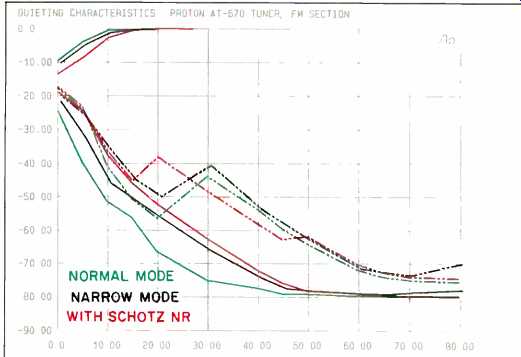
Fig.
2-FM quieting characteristics for both i.f. modes and for "Narrow" mode
with Schotz Noise Reduction. Solid curves at top are audio output, dashed
curves are stereo noise, and solid curves at bottom are mono noise.
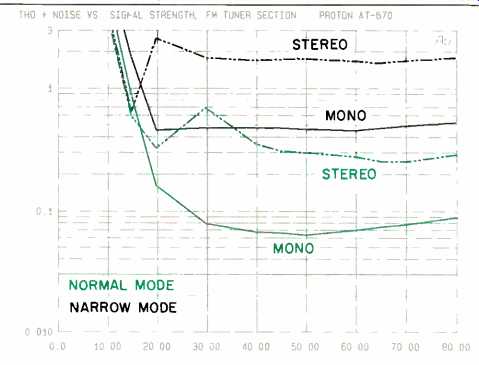
Fig. 3-THD + N vs. FM input signal level.
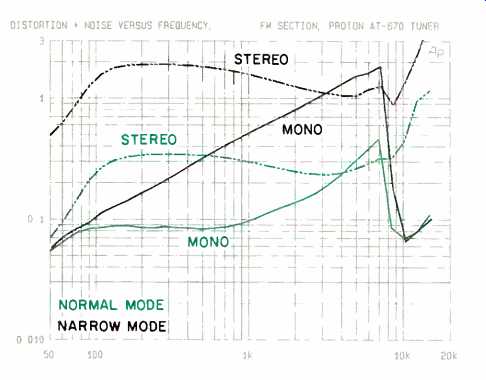
Fig. 4-THD + N vs. FM modulating frequency.

Fig. 5--FM frequency response (top) and separation.

Fig. 6--Spectrum analyses of modulated left channel (solid curve, top)
and unmodulated right channel (dashed curve, bottom), for " Normal" i.f.
mode (A) and "Narrow" mode (B), with 5-kHz modulating signal.
Use left-hand scales for top curve, right-hand scales for bottom.
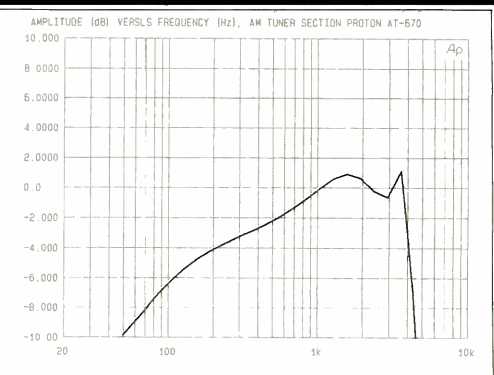
Fig. 7--Frequency response, AM section.
I obtained close correlation between the results shown in Fig. 3 and those shown in Fig. 4. The latter graph shows THD + N versus modulating frequency. In the "Narrow" mode, mono distortion tends to rise rapidly with frequency, so that at 6 kHz (the highest frequency at which THD must be reported to conform to the EIA/IEEE Standard) it measures a very high 1.7%. Clearly, with this tuner it is advisable to use the " Normal" i.f. mode whenever possible.
As is usually the case, FM separation was considerably higher when using the " Normal" i.f. mode than when using the "Narrow" setting (Fig. 5). In " Normal" mode, separation at 1 kHz measures 46.5 dB, decreasing to 41 dB at 100 Hz and to 39.8 dB at 10 kHz. In "Narrow" mode, separation is reduced to only 36.5 dB at 1 kHz, 27.8 dB at 10 kHz, and 36.5 dB at 100 Hz. Of course, these are still perfectly acceptable levels as far as good stereo imaging is concerned, but the lower numbers are a direct result of the narrower i.f. bandwidth.
Figures 6A and 6B are spectrum analyses of left- and right-channel outputs when the tuner is fed a stereo signal whose left channel is modulated by a 5-kHz tone. The solid curve in each case is the output of the modulated channel, and the dashed curve shows the crosstalk products in the output of the unmodulated channel. While residual subcarrier components at 19 and 38 kHz appear to be about the same in either i.f. mode, the harmonic levels (at 10 kHz, 15 kHz, and so on) are considerably lower in the " Normal" i.f. mode (Fig. 6A). Capture ratio measured 1.2 dB. Image and i.f. rejection were both close to the 100-dB mark, the greatest rejection figures I can measure with my test equipment. Alternate-channel selectivity was 65 dB in the " Normal" i.f. mode and 82 dB in the "Narrow" mode. AM rejection measured 65 dB, as claimed.
At 30% modulation, harmonic distortion of a 1-kHz modulating signal for the AM section was 0.42%, better than the 0.5% at 400 Hz specified by Proton. However, the AM section's frequency response (Fig. 7) was so disappointing that I saw no purpose in testing this section any further. I can't imagine why Proton allowed an otherwise excellent tuner to exhibit such attenuation (the -6 dB point occurs at 110 Hz), especially since the -6 dB point for the treble end of the curve occurs at a better-than-average 4.2 kHz.
Use and Listening Tests
Despite the minimal number of front-panel controls, set ting up presets for this tuner proved to be quite simple. The " + " and "- " rocker switch normally used to access pre sets is also used in combination with the "Memory" and "Enter" switches to create and store those preset frequencies initially. The operation of the rotary tuning control was quite elegant too. When you are in the automatic tuning mode, a slight rotation of the knob in either direction sets the tuning system up or down in frequency until the next usable signal is encountered. If you select manual tuning, however, rotating the control changes the tuned and displayed frequencies in 50-kHz increments.
Sensitivity of the tuner proved to be excellent. With my rotatable multi-element outdoor antenna, I was able to pick up some 58 usable signals, of which 47 were received in stereo. Of these 47 stereo signals, six were initially too noisy to be enjoyed in stereo. Switching on the SNR circuit made all but one of them acceptably quiet. Having discovered how effective the Schotz Noise Reduction circuit was, I simply left it on for the remainder of my listening tests.
These days, all too few FM stations put out the kind of clean, wide-range signal that can benefit from being received by a tuner such as the AT-670. If you are fortunate enough to live in an area where some FM stations are worth listening to, the Proton AT-670 is certainly a tuner worth owning and enjoying. After all, digital audio broadcasting, from the looks of things, is still many years away. Mean while, the AT-670 is a worthwhile alternative!
-Leonard Feldman

(Source: Audio magazine )
Also see:
Proton D540 High Current Amplifier (July 1985)
Rotel RT-2100 Stereo FM Tuner (Sept. 1979)
= = = =